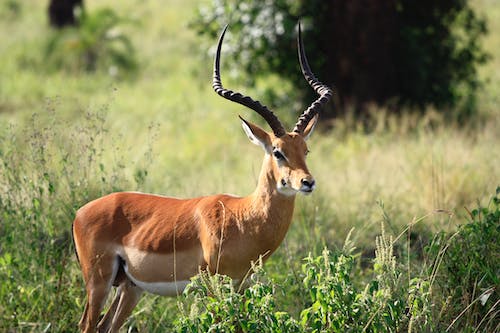ANIMAL: Impala Aepyceros melampus Type of Animal: Antelope Habitat: Savanna, grassland, savanna-grassland mosaic, woodland, areas between savanna & woodland, shrubland, woodland edges/fringes, bushland, bushveld, ecotones between grassland & woodland, grassland edges, savanna edges, bush-grassland mosaic, scrub forest, floodplains, artificial wetlands Location(s): E & southern Africa Appearance: Reddish-brown to rufous-fawn antelope w/ paler cream underbelly, only males have curved twisted horns, Black-faced subspecies larger than Kenyan/common subspecies w/ black stripe down middle of face, “M”-like marking on rear Food/Diet: Grasses, leaves, bushes, pods, fruit, herbs, succulents, shoots, shrubs, bark, wood, stems, monocots, dicots, forbs, flowers, browse, seeds, sprouts, greens Status in Wild: Stable Conservation: Breeding in zoos, wildlife parks, & ranches. Translocation of threatened Black-Faced subspecies. Lifestyle: Breeding herds consist of a male w/ 15-100 females & offspring. Bachelor herds typically have 6-10 individuals. Mixed-sex herds of up to 200 animals occur out of breeding season. Additional Info: Called: Male: Ram/Buck Female: Ewe/Doe Young: Fawn/Lamb/Calf Group: Herd Weight: Male: 117-168 lbs Female: 88-117 lbs Young: 25 lbs Gestation: 6-7 months Life Span: 12-15 years Height: Male: 2.5-3 ft Female: 2.3-2.75 ft Body Length: 3.92-5.25 ft, same for both sexes Tail Length: 1-1.5 ft, same for both sexes Main predators of adults are lions, hyenas, wild dogs, leopards, cheetahs, crocodiles, pythons, caracal, jackals, & eagles. Servals & baboons prey on young. Young are concealed for 1st few weeks of life. To confuse predators, herd will scatter in all directions. During breeding season, male impala spend ¼ of their day trying to round up receptive females & guarding territory, leading to less feeding as well as weight loss. Males make roaring sound during breeding season. They also make snort sound. These antelope are quite skittish & will even make false alarm calls. Active during day (diurnal). Have excellent hearing, sight, & smell. Males darken during breeding season & become more territorial, patrolling/roaring/scent-marking. Upward leaping seen in this species known as pronking. Fun Fact(s): Famous Chevrolet Impala named for this antelope. These animals sometimes used in Biltong (dried cured meat similar to jerky). Due to being favorite prey item of many predators, often called “McDonalds of the Savanna” or “McDonalds of the bush.” Also get name due to M-shaped mark on backside. Can leap as far as 33 ft & as high as 10 ft.
